When you travel to Uzbekistan by air you will most likely fly into Tashkent, the capital of the country. Most visitors leave the city right away and head to the more popular places of Uzbekistan Samarkand, Bukhara and Khiva. Yes, maybe Tashkent cannot compete with these jewels on the Silk Road but nevertheless it has a lot to offer. People who don’t spend time in Tashkent won’t see the Chorsu Bazaar, the Hazrati Imam Mosque, the Moyie Muborak Museum, the Barak Khan Medressa, the Kaffal-Shashi Mausoleum, the Kukeldash Medressa and the Amir Timur Monument. These are only a few of the highlights of Tashkent and can be easily seen within 24 hours.
I was exhausted when I left my hotel which was situated at the Amir Timur Square. I hadn’t slept much the night before because my luggage had gotten lost on my flight from Düsseldorf to Tashkent (more about that in a different post). As a result I had spent three hours at the airport in the middle of the night and hadn’t gotten into my hotel until 4 AM. Nevertheless I wanted to see a bit of Tashkent.
The Amir Timur Monument
I started my exploration at the Amir Timur Monument, right in front of the hotel. It was inaugurated in 1993 in honour of Amir Timur (1336 – 1405), a Central Asian military leader. He didn’t stem from a mighty family but he was related to Tschagatai Chan, one of the sons of Dschingis Khan. Amir Timur build an empire which stretched from the transcaucasus region via Northern India all the way to Iran, Afghanistan and Syria. Almost one million people followed his military campaigns. Amir Timur also errected gorgeous buildings like the Bibi-Khanym Mosque and the Gur-E-Amir Mausoleum in Samarkand. The latter is his tomb which is also the resting place of some of his family members, inter alia Shahrukh Mirza and Ulugh Beg, the son and the grandson of Amir Timur.
 Amir Timur Monument
Amir Timur Monument
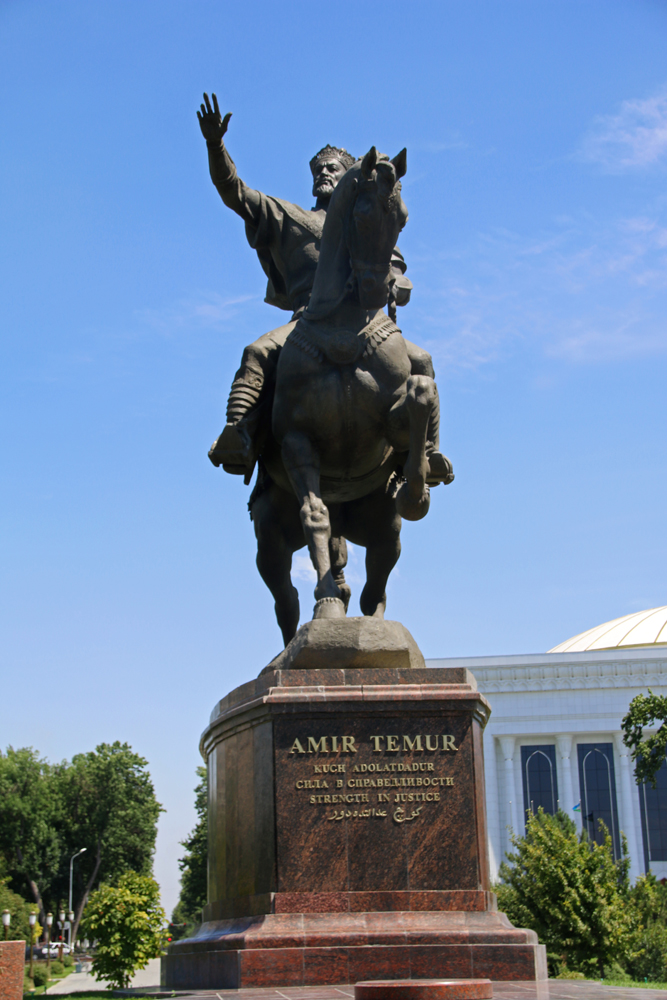
Tashkent Metro
Next I headed to the metro station Amir Timur which was only a few steps away. I bought a ticket which was a kind of a chip and cost 1000 Uzbek Som (0.30 Euros), no matter how far you go. When I returned to Tashkent after my trip through Uzbekistan a metro train ride cost 1400 Som (0.41 Euros). I took the red line to Alisher Navoiy/Paxtakor and changed to the blue line which took me to Chorsu.
The Tashkent Metro is a highlight itself because the stations are beautifully designed. There are pillars, chandeliers and wall paintings in some of them, each representing a different topic. Particular hightlights are the stations Alisher Navoiy, Oz’bekiston and Kosmonavtlar. Unfortunately photography is strongly prohibited and monitored through security guards at the entrances and exits of the stations where you need to show your bag contents. Sometimes even the photos on your camera’s SD card are controlled. I know that some people still take photos of the metro stations but I wanted to avoid any trouble so I renounced on that.
The Tashkent metro was inaugurated with the red line in 1977 and was the first metro of Central Asia. The blue line started to operate in 1984 and the green line followed in 2001. A fourth yellow line is in planning.
Chorsu Bazaar
A sea of voices received me at the Chorsu Bazaar. It is located in a turquoise blue-domed building and its adjacent areas. When entering I encountered a hustle and bustle. Vendours and clients haggled and negotiated quantities and prices. Soon I was involved. Vendours offered me dried fruits and nuts. I was handed spices to smell. Of course the vendours tried to convince me to buy their products but they weren’t pushy.
 Chorsu Bazaar
Chorsu Bazaar
 This guy didn’t want to sell me something, he wanted to give me the melon as a present
This guy didn’t want to sell me something, he wanted to give me the melon as a present
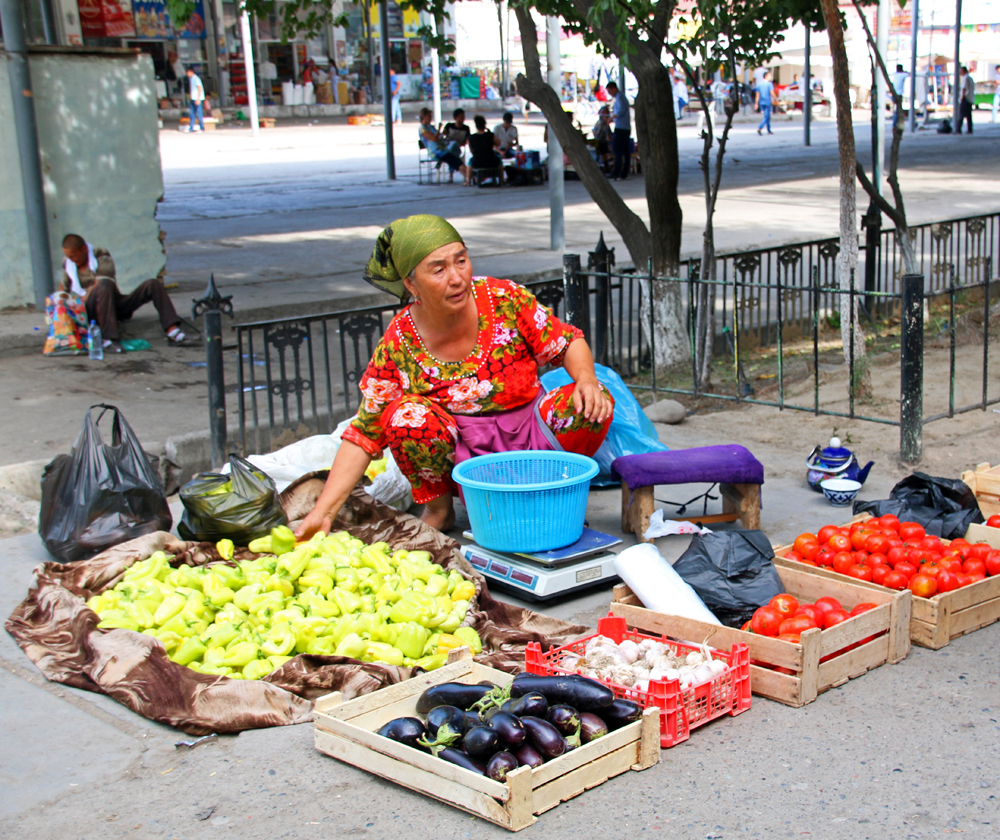
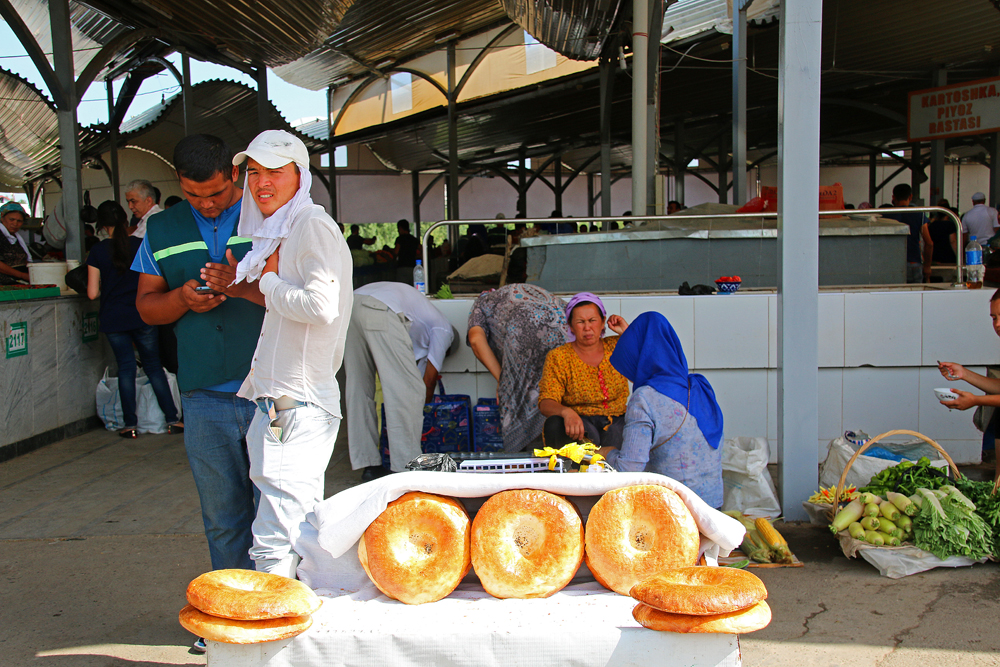

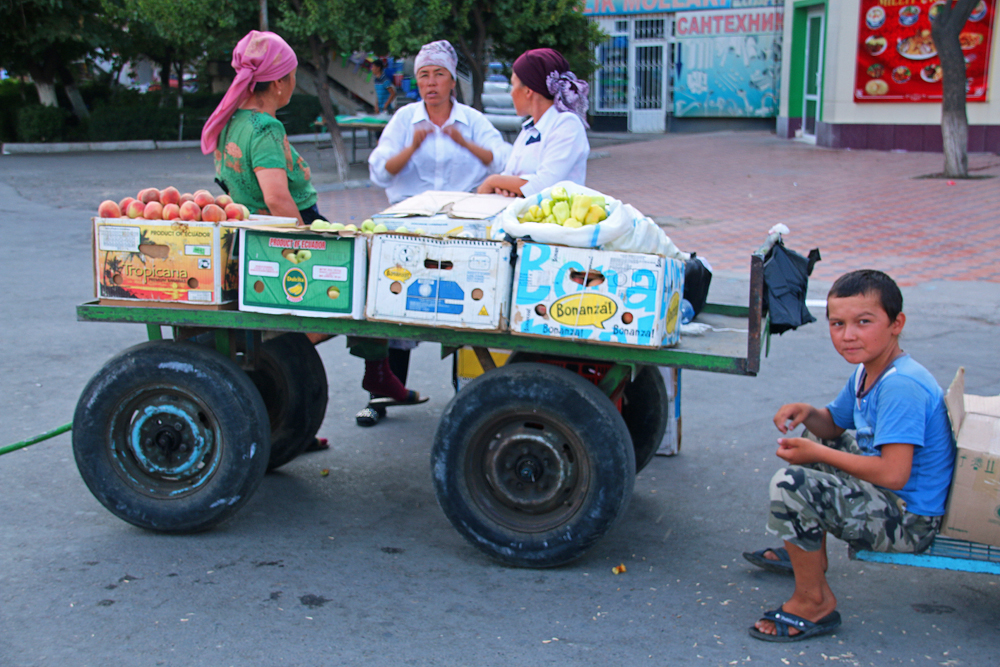
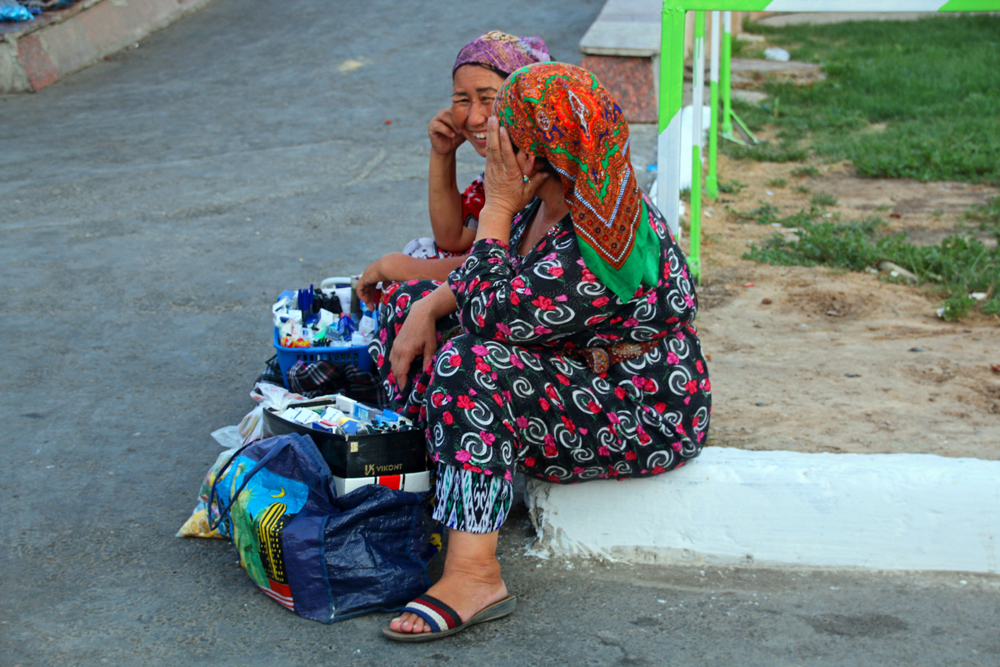
From fruits, vegetables, nuts, spices, handicrafts, jewellery, potteries, clothing and housewares you could get almost everything in the Chorsu Bazaar. Most of the fruits are from Uzbekistan, mainly from the fertile Fergana Valley. There is also a zone with foodstalls where you can satisfay your hunger right away. A bit weird for westerners might be the baby cribs in Uzbekistan which come with a drain whole and which you can also buy at the Chorsu Bazaar. Babies are actually strapped there to make sure that they hit the drain whole.
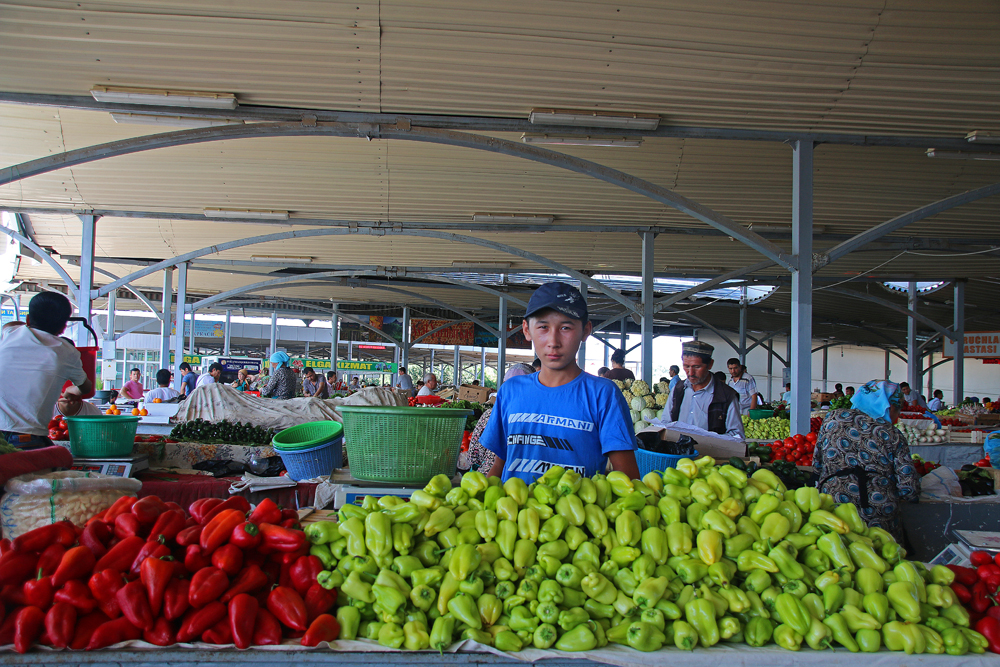 Young vegetable vendour inside the Chorsu Bazaar
Young vegetable vendour inside the Chorsu Bazaar
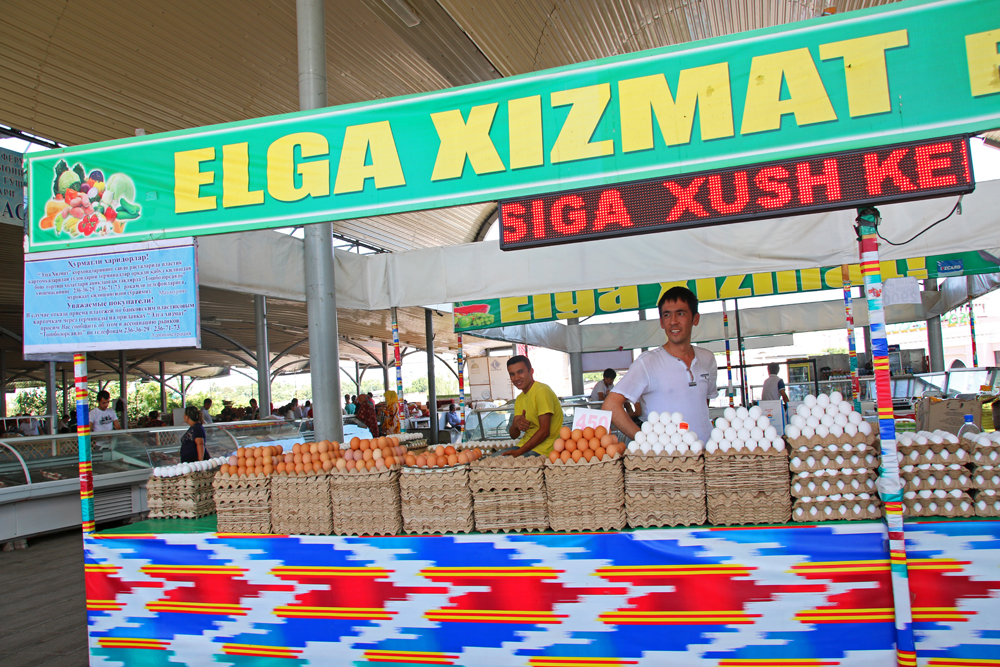 Egg vendours at the Chorsu Bazaar
Egg vendours at the Chorsu Bazaar
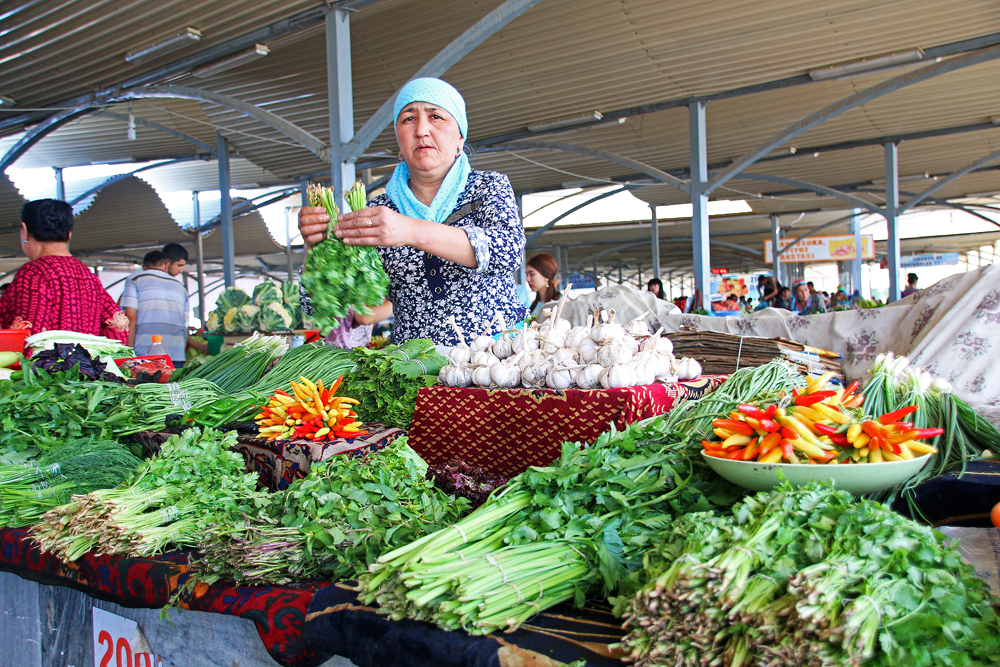 Fresh vegetables from Uzbekistan
Fresh vegetables from Uzbekistan

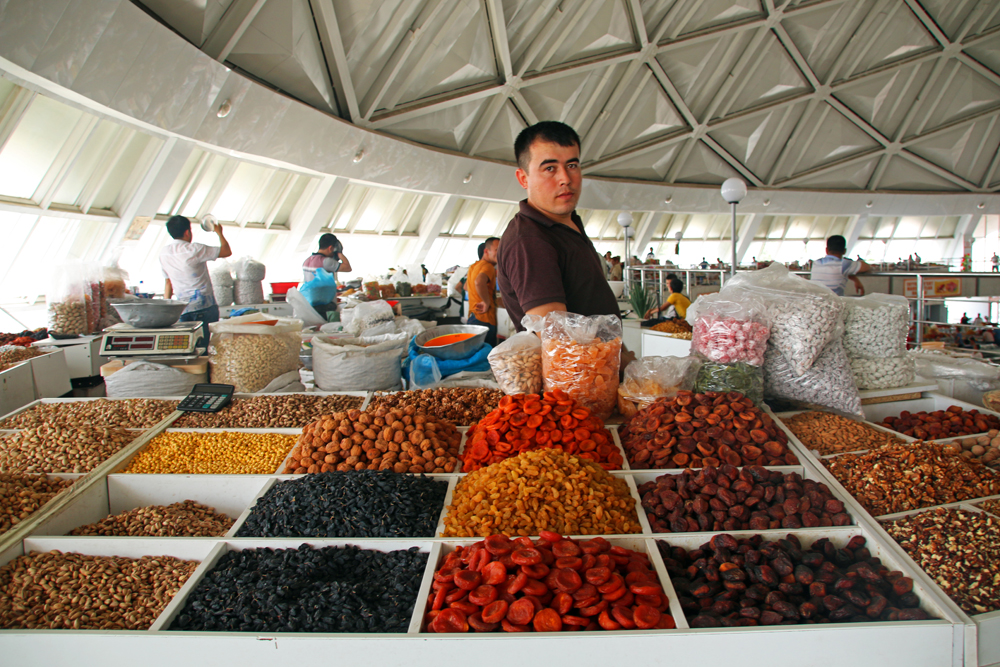 Dried fruits and nuts are available in many places in Uzbekistan
Dried fruits and nuts are available in many places in Uzbekistan
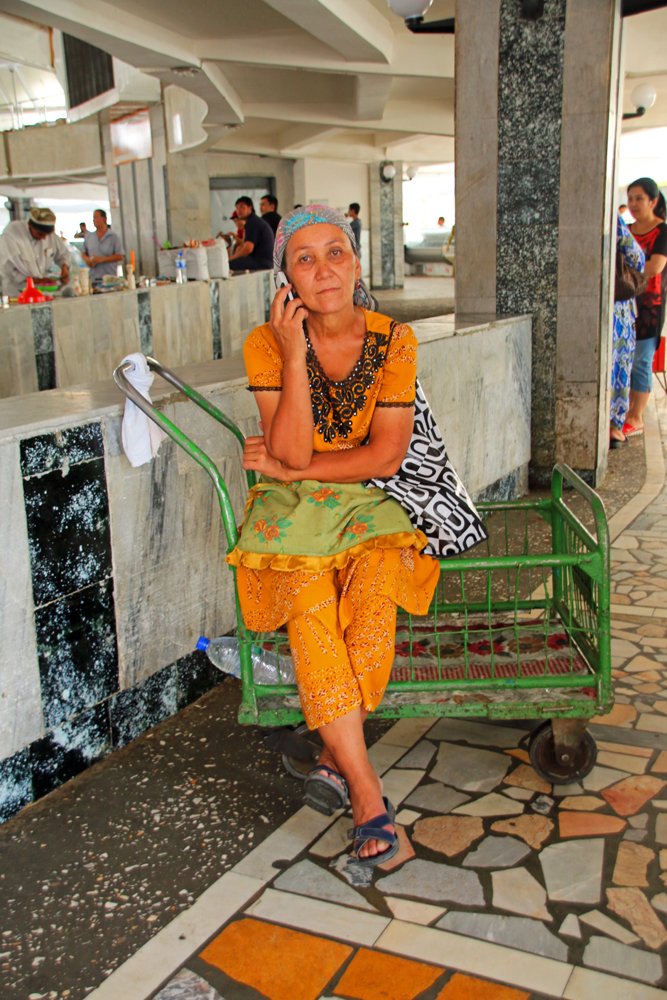 Break
Break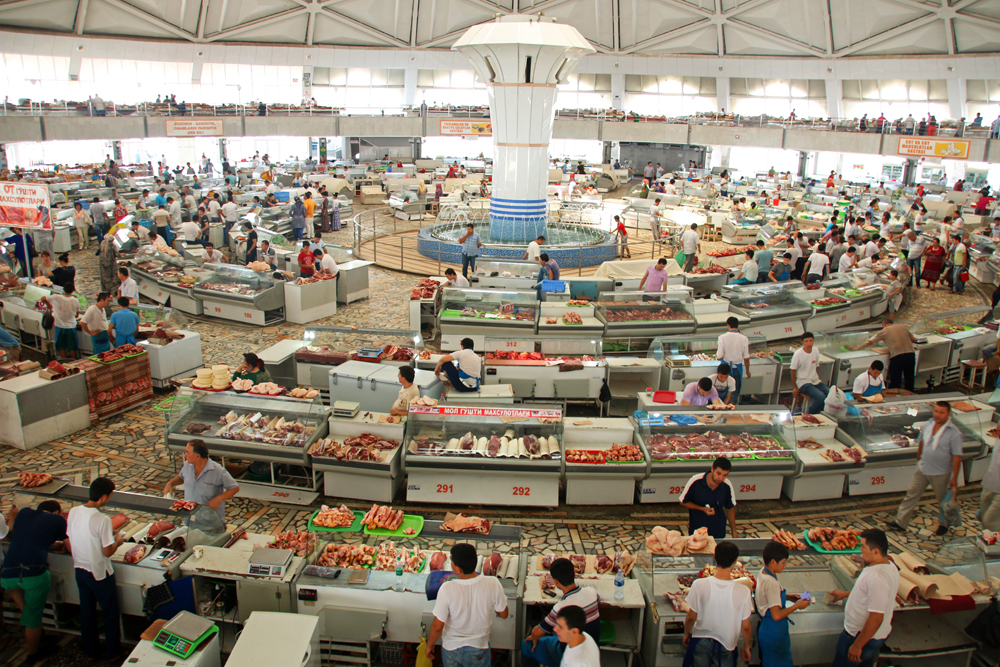 Market hall from above
Market hall from above
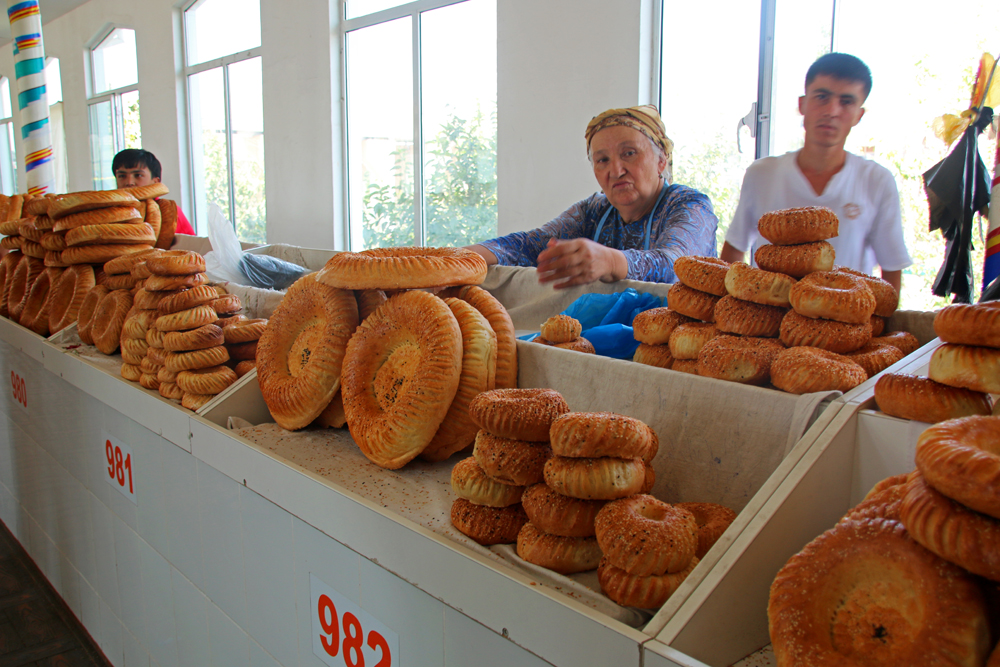 Old lady is selling nan bread
Old lady is selling nan bread
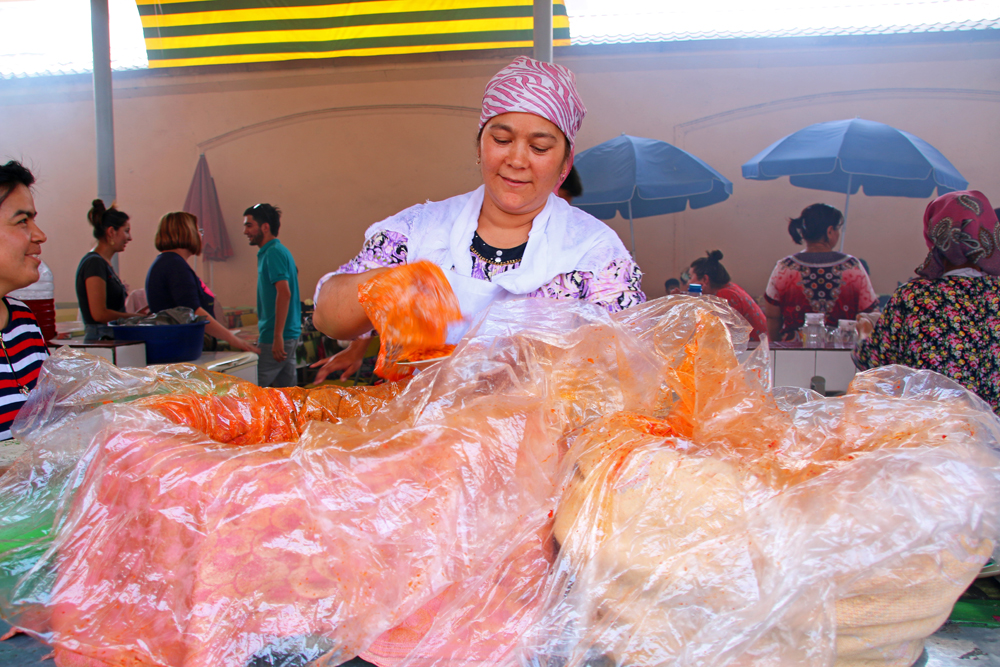 Food stand in the Chorsu Bazaar
Food stand in the Chorsu Bazaar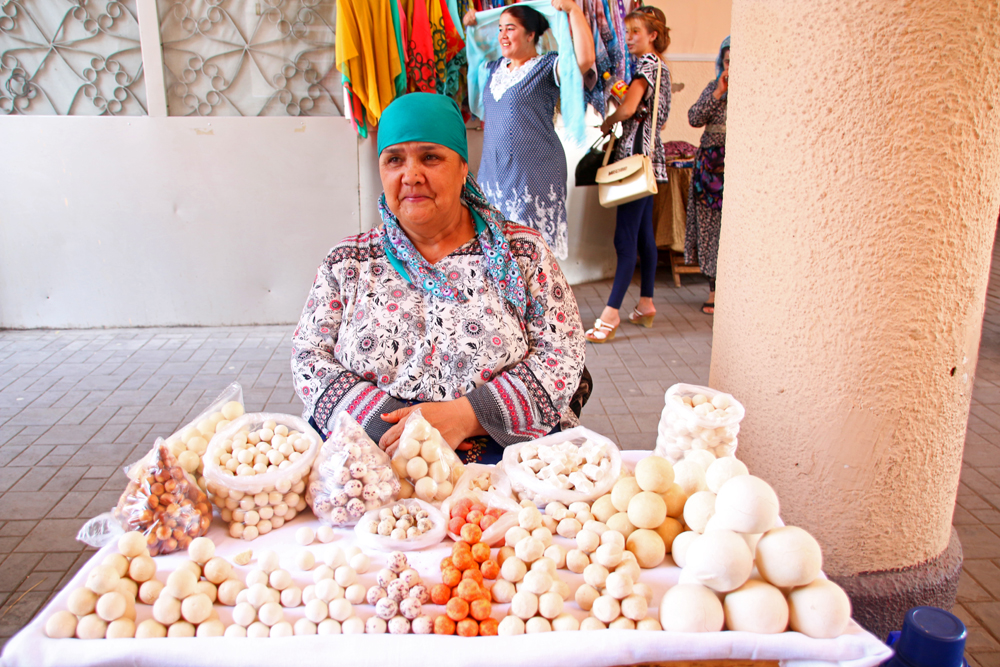
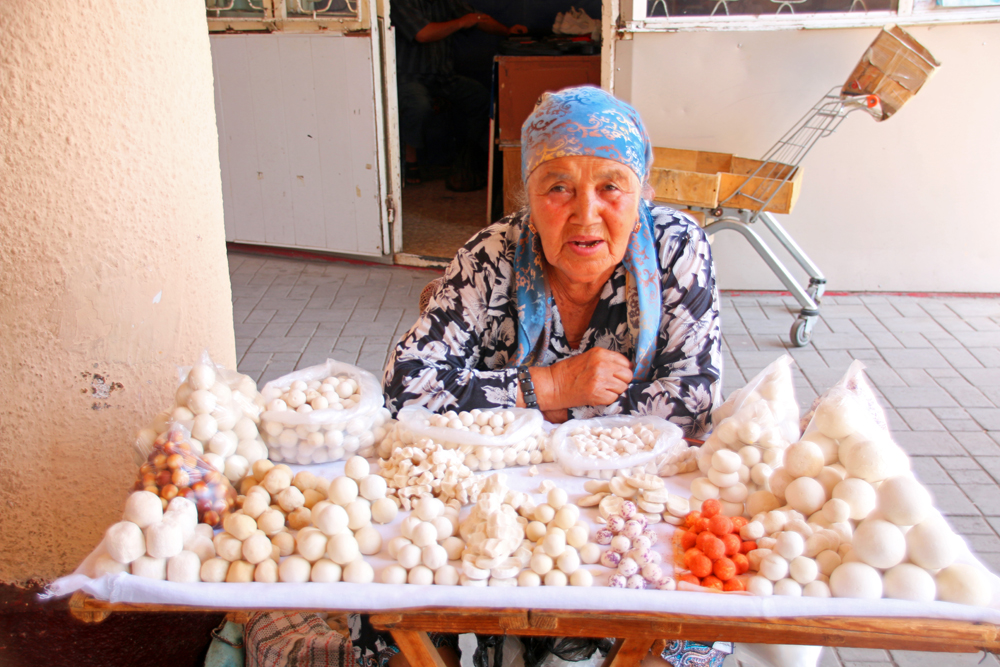

 Shashlik vendour at the Chorsu Bazaar
Shashlik vendour at the Chorsu Bazaar
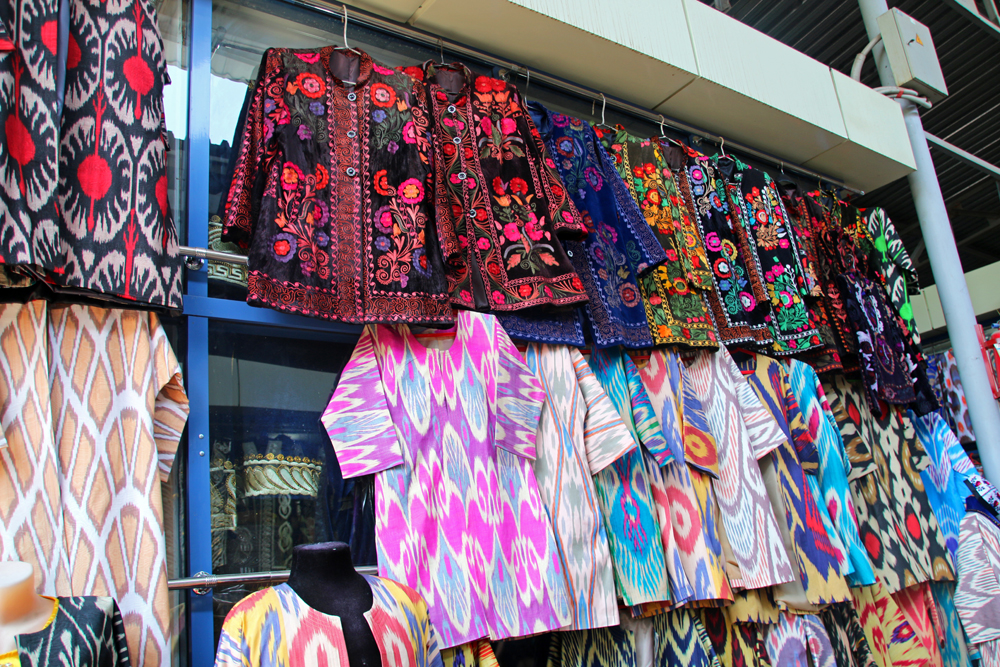 Clothing is also available in the Chorsu Bazaar
Clothing is also available in the Chorsu Bazaar
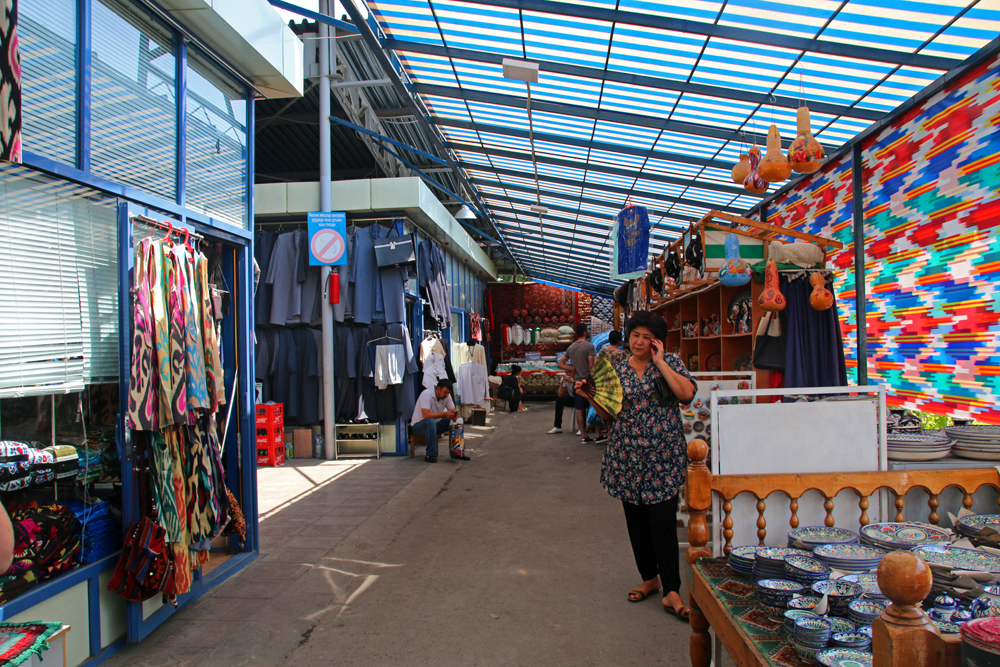
 Handicraft
Handicraft
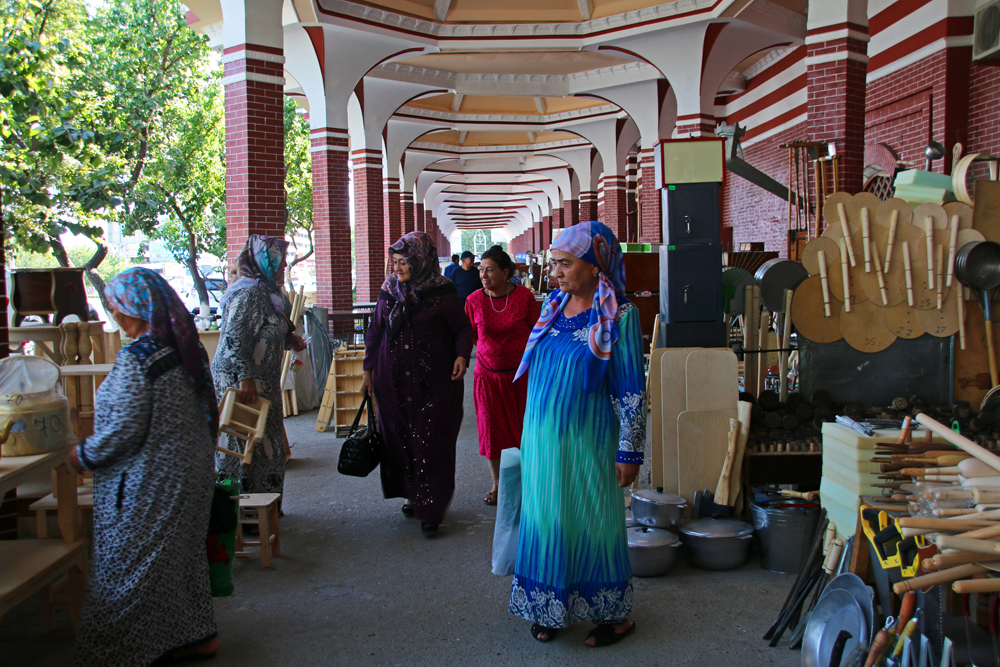
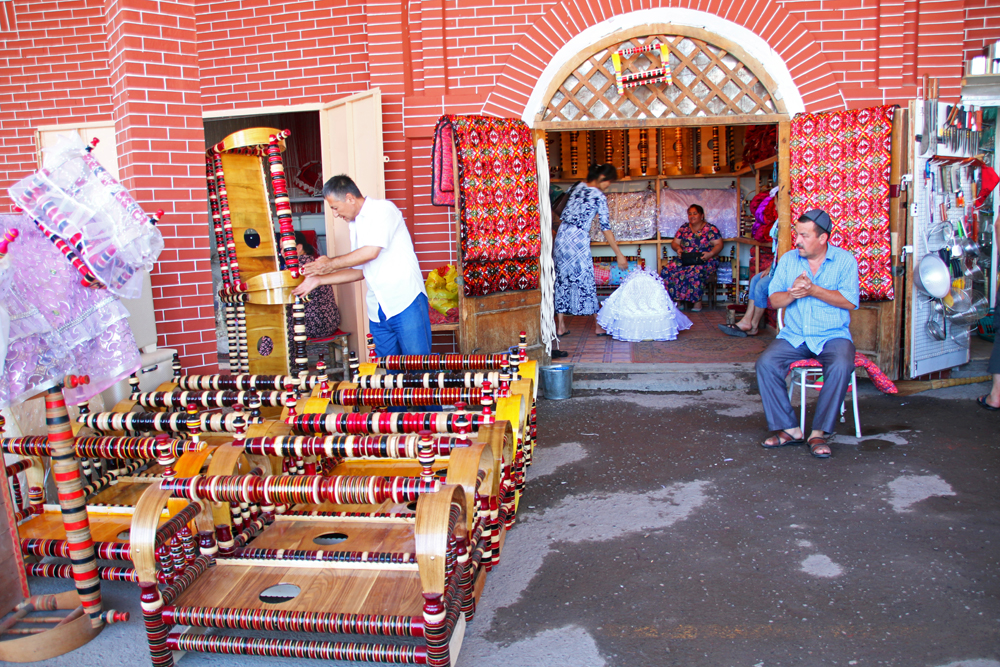 Uzbek baby cribs with a drain whole
Uzbek baby cribs with a drain whole
In former times the Chorsu Bazaar was one of Central Asia’s busiest and liveliest bazaars and is still the largest market in Tashkent. It gives a great insight into the atmosphere of market life on the Silk Road. The Chorsu Bazaar is situated behind the Kukeldash Medressa and the Juma Mosque. It is open daily from 9 AM to 6 PM.
The Khast Imam Square
In the evening of that day I met with thirteen people from different countries with whom I travelled through Uzbekistan. My travelmates came from Australia, Thailand, the US, Norway, the UK, Austria, Hungary, Serbia and Germany. Our local Uzbek guide was a young female from Tashkent.
When we got back to Tashkent after our journey through Uzbekistan we visited the Khast Imam Square on a city tour. This is the religious centre of Uzbekistan and encompasses the Hazrati Imam Mosque, the Barak Khan Medressa and the Mausoleum of Abu Bakr Kaffal Shashi. I returned and explored the historic highlights of Tashkent more in-depth by myself the following day.
 Part of the Khast Imam Square
Part of the Khast Imam Square
Hazrati Imam Mosque
Like on our city tour with the group I started at the Hazrati Imam Mosque or Leviathan Hazroti Imom Friday Mosque the following day. Although it is regarded as a historic sight the Mosque is not really old. It was built in 2007 within only four months on behalf of President Karimov and offers space for 2500 believers. The Hazrati Imam Mosque is dominated by two turquoise domes and two minarets rising to a height of 53 metres. It has a courtyard which is equipped with twenty carved columns of sandalwood.
 Hazrati Imam Mosque
Hazrati Imam Mosque
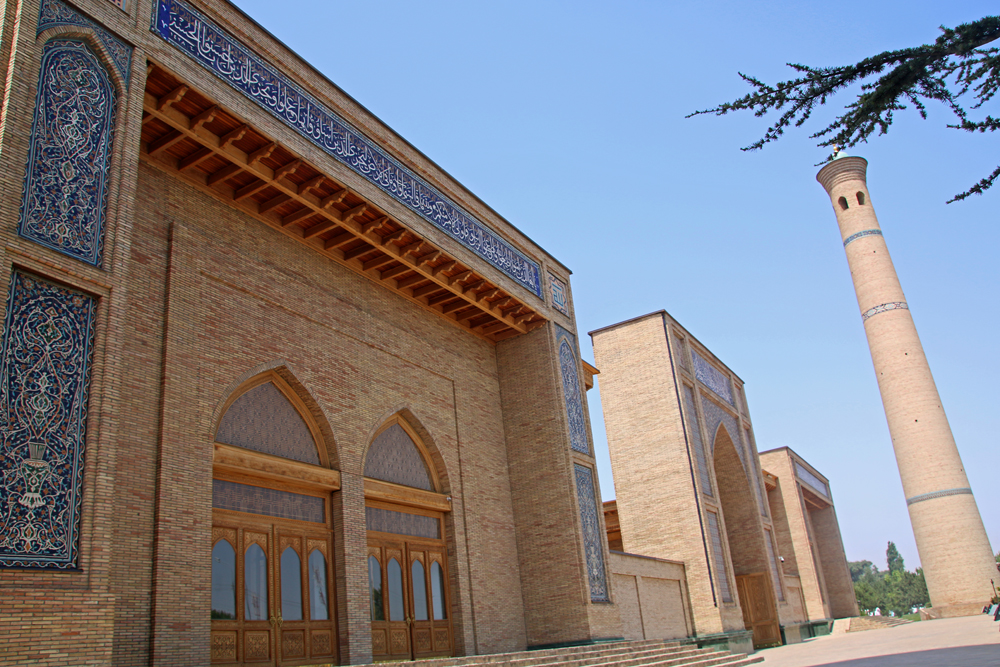
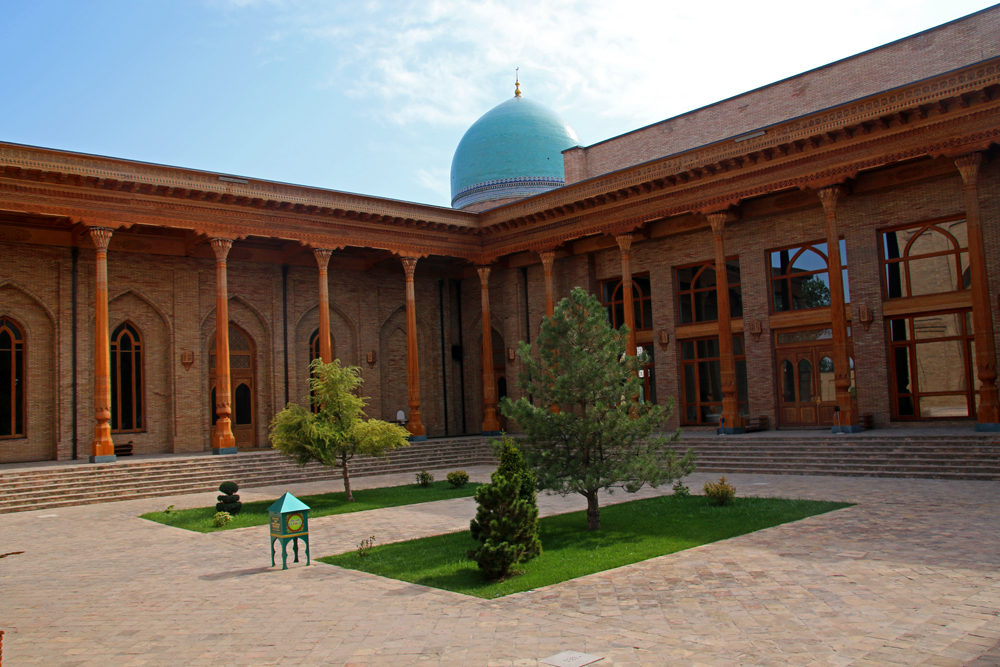 Courtyard of the Hazrati Imam Mosque
Courtyard of the Hazrati Imam Mosque
 Finely carved-column of the mosque
Finely carved-column of the mosque
Moyie Muborak Library Museum
From the Mosque I headed to the Moyie Muborak Library Museum which was only a few steps away. It hosts the 7th century Osman Quran, supposed to be the world’s oldest, and other rare manuscripts. Moyie Muborak means “scared hair”. because a hair is preserved here which is supposed to have belonged to the Holy Prophet Muhammad, hence the name. Photography is not allowed inside.
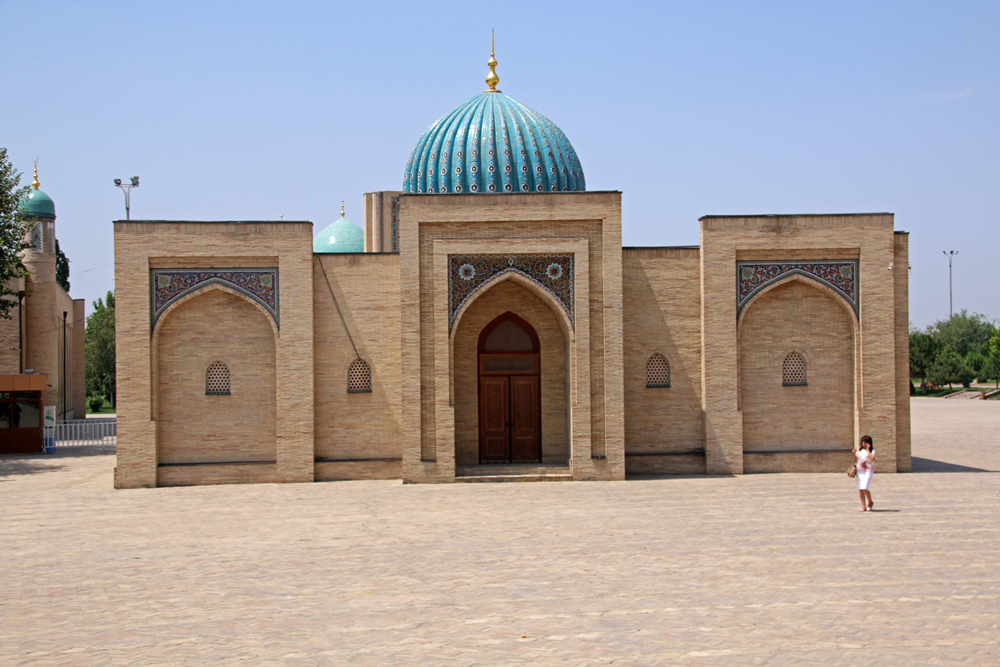 Moyie Muborak Library Museum
Moyie Muborak Library Museum
Barak Khan Medressa
Turquoise domes also mark the Barak Khan Medressa, my next stop in Tashkent. It is located at the west side of the Khast Imam Square and was built in the 16th century on the initiative of Nauruz Ahmadhan. A medressa is a koran school where students live and study. The Barak Khan medressa is not an active koran school anymore. In its center is a courtyard which leads to the 30 former student rooms and to the lecturer halls. While it was home of the Muslim Board of Uzbekistan between 1950 and 2007 a few of the students rooms now inhabit handicraft shops.
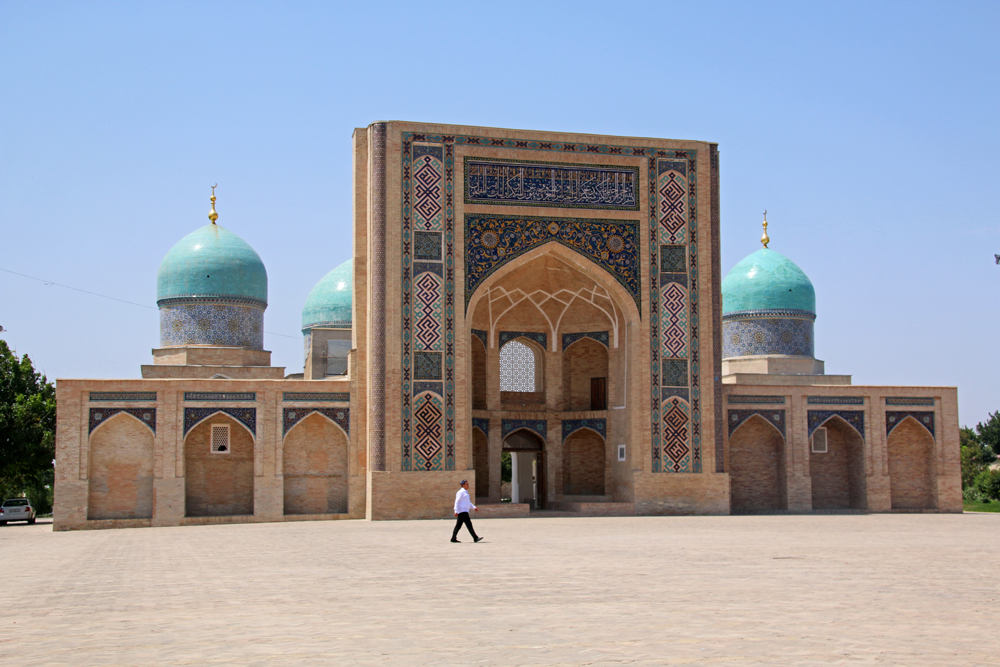 Barak Khan Medressa
Barak Khan Medressa
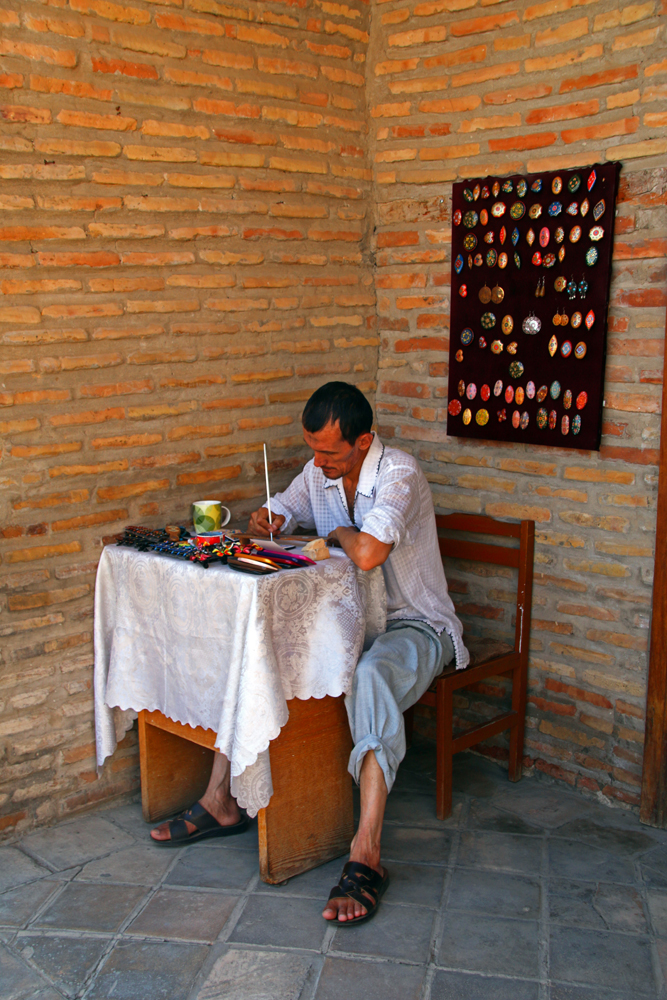 Artist in the Barak Khan Medressa
Artist in the Barak Khan Medressa
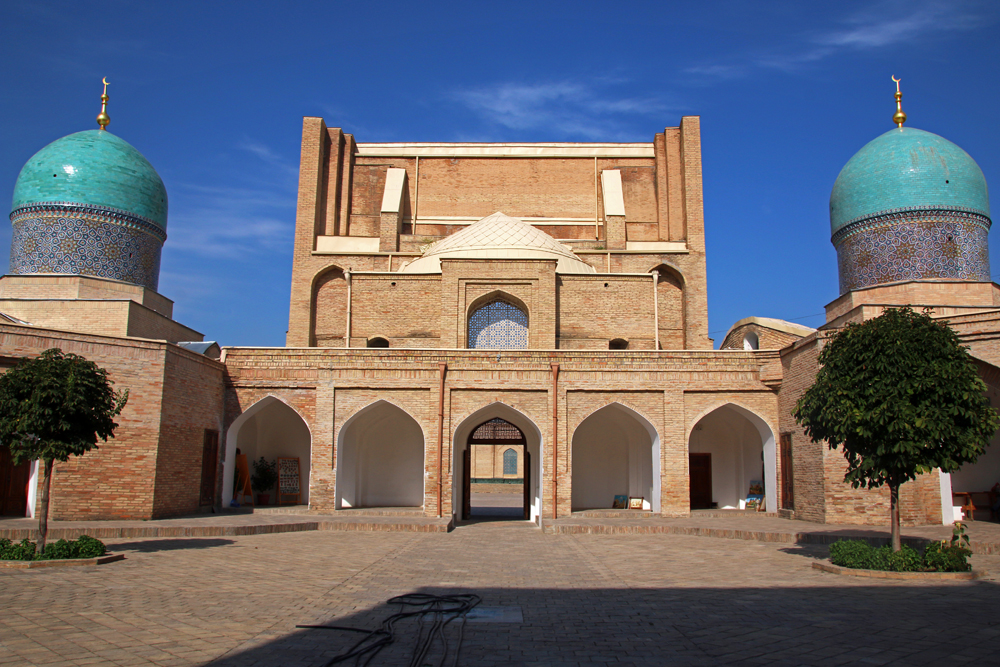 Courtyard of the Barak Khan Medressa
Courtyard of the Barak Khan Medressa
 View of the Hazrati Imam Square from the courtyard of the Barak Khan Medressa
View of the Hazrati Imam Square from the courtyard of the Barak Khan Medressa
Kaffal Shashi Mausoleum
From the Barak Khan Medressa I wandered to the Kaffal Shashi Mausoleum. It was also constructed in the 16th century and is situated next to the Barak Khan Medressa. The Kaffal Shashi Mausoleum is the tomb of Imam Abu Bakr Kaffal Shashi who died in 926. The current building was constructed in 1542 and is the oldest of the sights on the Khast Imam Square.
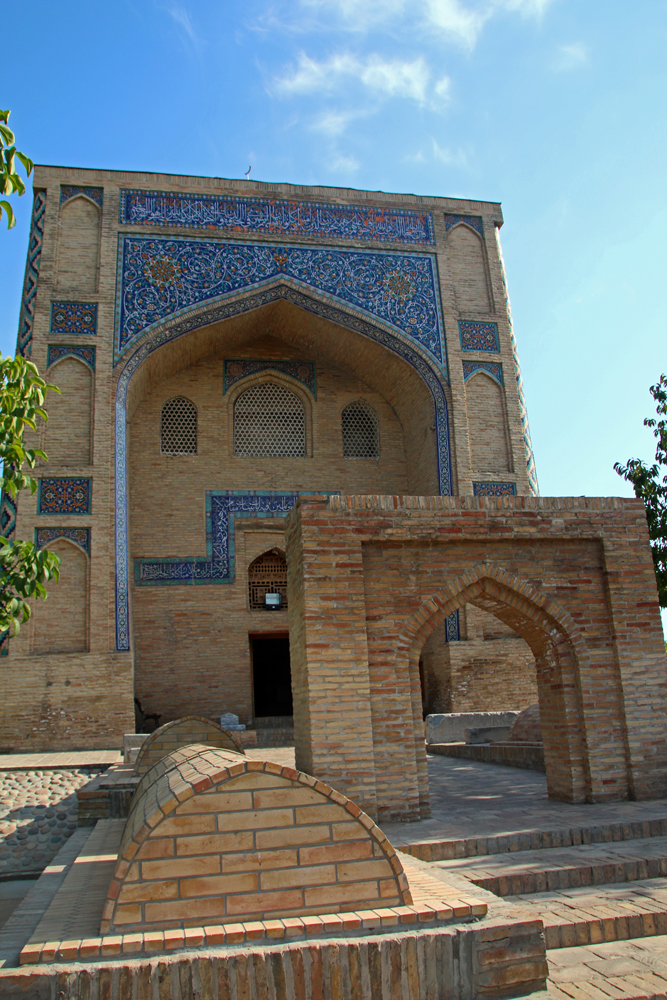 Kaffal Shashi Mausoleum
Kaffal Shashi Mausoleum
Next to the mausoleum is the Imam al-Bukhari Institute, a post-medressa academy. On our common city tour we met a group of female and a group of male students. Of course we didn’t know if they studied there but they smiled at us and posed for our photos.
 Uzbek students
Uzbek students

Kukeldash Medressa
Unfortunately I didn’t have enough time to visit the Kukeldash Medressa which is located right next to the Juma Mosque. Also on the city tour with the group we only saw the medressa from outside. It was built in the 16th century by Indian workers under control of the Wesir Kukeldash who was said to be a cruel ruler. The Kukeldash Medressa hosts 38 tiny rooms of only four square metres which two to three students had to share. Due to legends unfaithful wifes were executed in the Kukeldash Medressa. They were tied up in a sack and the sacks were thrown on the streets from a height of twenty meters.
 Kukeldash Medressa
Kukeldash Medressa
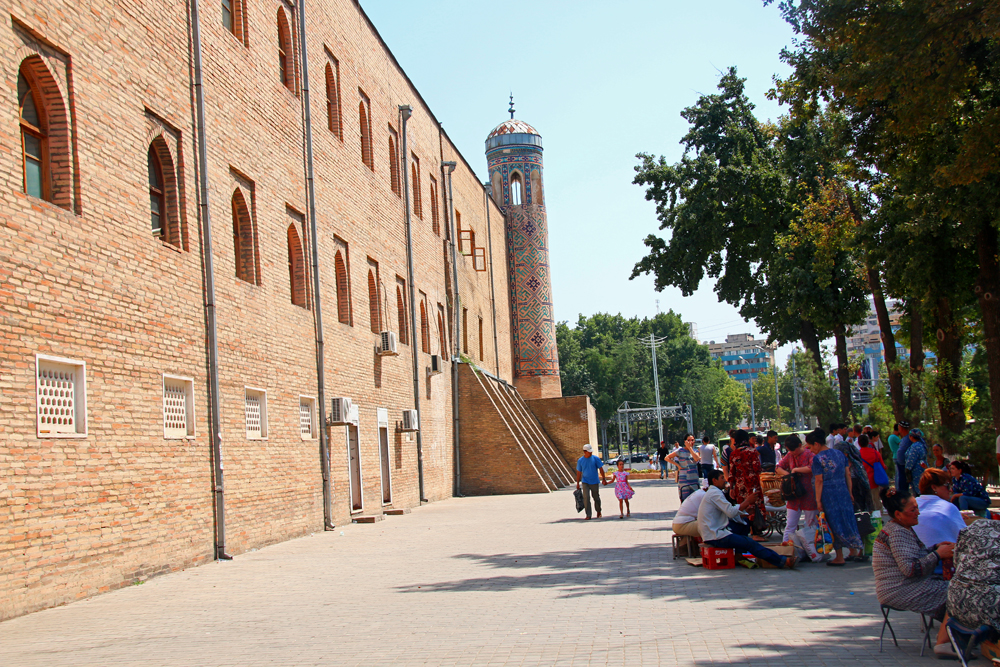
Museums
There are several museums in Tashkent but due to the lack of time I didn’t go to any of them. I like to take my time to explore the highlights of a place in-depth. If I tried to squeeze one or two museums into my schedule for Tashkent it would have been a rush from place to place. The Amir Timur Museum is very close to the Amir Timur Monument and gives visitors an insight into everyday life during the regency of Amir Timur. It also presents coins, applied arts, scripts and models of Central Asian cities. Other museums which might be interesting are the Museum of Applied Arts, the Museum of Fine Arts, the Museum of History and the Navoi Literary Museum but there are a few more. The website of Visit Uzbekistan provides a list of the most visited museums in Tashkent.
 Amir Timur Museum
Amir Timur Museum
Tashkent TV Tower
I also didn’t go to the Tashkent TV Tower which is located near the amusement park Toshkentland. With 375 metres it is the highest TV Tower of Central Asia and one of the highest worldwide but I am not sad I wasn’t there. Two of my travelmates specifically went there to take photos. They were told that you are allowed to go up but that you are not allowed take photos from the oberservation desk but only from the ground.
Before heading to the airport I took a walk through the neighbourhood of the hotel. I happened to meet a Uzbek wedding party and was invited to join them. I was tempted to accept the invitation but I had to catch my flight. In August 2014 I was lucky to attend a Chinese wedding of friends of a friend of mine and it was a special experience for me. Although I neither knew the Uzbek bridal pair nor their friends it would have for sure been a very authentic Uzbek experience and a wonderful end of my exploration of the highlights of Tashkent.
 Uzbek bridal pair in Tashkent
Uzbek bridal pair in Tashkent
 Dom Forum
Dom Forum
Tips and informations for Tashkent and Uzbekistan
Entry and exit
When arriving in Uzbekistan, no matter if you are getting in by plane or overland, you must fill in two similar declaration forms (the same form twice). There you have to enter every single cent of every currency you bring into the country. You should also mention your electronic devices like laptop, camera, iPad or tablet and the purchase price of these items. Both forms will be stamped. You have to keep one of these forms because you have to show it again when leaving the country. You have to fill in another two declaration forms when leaving the Uzbekistan. Make sure that you leave the country with less money (US-Dollar, Euros) than you had when you entered. Mention every Euro and every US-Dollar you have left. You are not allowed to take Uzbek Som out of the country. Also enter your electronic devices including the purchase price again. The declaration forms might be in Russian but there should be an English translation form. If it is not there explicitly ask for it.
Money
Take cash to Uzbekistan and exchange it on the black market, you’ll get a much better rate there. There is a black market literally everywhere. You don’t need to search for these guys, people will approach you and ask if you want to exchange money. The higher the risk the more money you might get. To avaoid getting counterfeit money it is probably safer to exchange money with a trustworthy person than with a random foreigner in the streets. Euros and US-Dollars are equally excepted. Only if you want to pay for handicrafts in cash, US-Dollars might be preferred. But you can pay for it also in Som.
Credit cards – not matter if Visa or Master – won’t help you much in Uzbekistan. You might need them to pay for hotel rooms but except of that they are often useless. ATMS are often cashless and if you manage to withdrawl money from an ATM machine it might be US-Dollar cash. That often comes with a fee.on top.
Accommodation and transfer:
I stayed at the Hotel Uzbekistan which is located at the Amir Timur Square. It was also the joining hotel of my adventure tour through Uzbekistan. I spent one extra night before the start of the trip and paid 67 US-Dollars (60.88 Euros) for the room.
I had prebooked an arrival transfer from Tashkent airport to the hotel through Skyscanner which had cost me 21.85 Euros. The driver waited for me although I had to spend three hours at Tashkent airport in the middle of the night because of my lost luggage. For the way back to the airport I shared a taxi with two of my travelmates which cost 30.000 Som (about 10 US-Dollar) for the taxi, not per person.
If you would like to read my future posts about Uzbekistan or other destinations subscribe via email, follow me on Facebook, Twitter, Instagram, Google+ or Bloglovin. If you enjoyed this article I would be happy if you’d leave a comment below.
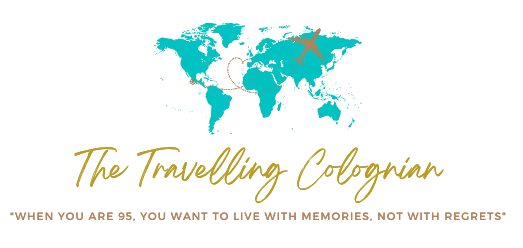
Just what I need as I’m planning to go to Uzbekistan maybe in two-year’s time. I always think of spending most of the time in Samarkand, Bukhara and Khiva. But I didn’t know Tashkent was actually quite interesting to explore with some historical places dating back to the 16th century. Beautiful photos!
Thanks so much for the kind words, Bama. Samarkand, Bukhara and Khiva are truly spectacular but Tashkent also has a lot to offer, more than most people think. I also recommend to consider Aydar Kŭl lake as a place to visit although it is probably not that easy to organize when travelling individually. Stay tuned – I will definitely write more about all these places in the future. :)
Bisher habe ich nur Fotos von den bekannten Höhepunkten Usbekistans wie Samarkand, Bukhara und Khiva gesehen. Unbekannt war mir, dass auch Taschkent so viele wunderbare Gebäude hat, ein unglaublich buntes und vielfältiges Geschehen aufweist und dass die Menschen so freundlich sind.
Ich finde es gut, dass Du auf den vielen Fotos auch einen umfassenden Einblick in das Leben der Bevölkerung zeigst. Die Bilder machen Lust, selbst dorthin zu fahren.
Sehr schöne Fotos!
Marie
Vielen Dank für Deine netten Worte, Marie. Usbekistan ist wirklich eine Reise wert, vor allem zur Zeit noch, wo das Land noch nicht so touristisch ist. Samarkand, Bukhara und Khiva sind aufgrund ihrer prächtigen Bauwerke natürlich besonders beeindruckend, man sollte aber auch Taschkent nicht unterschätzen und außer Acht lassen.
‘Love the photographs Vanessa.
Uzbekistan is not a well-known destination so it’s nice when people go to visit! The only reason that I know of the country is because I used to live in front of the Uzbekistan Embassy years ago, in Berlin, and they always used to wave!
‘Hope I go there myself someday.
‘Great post. xx
I absolutely love the fact that the staff of the Uzbek Embassy in Berlin waved to you, Victoria, when you lived just in front of it. The locals in Uzbekistan were super-friendly, warm-hearted, hospitable, curious and open-minded towards visitors of the country. I am happy that I travelled there already since it is still a hidden gem. I highly recommend to go there with your husband and son, rather sooner than later before mass tourism hits the country one day. Thank you so much for the kind words.
Seems like such a fascinating country, especially since not a lot of people visit. I love your market pictures – going to markets is one of my favorite things to do when I travel, such an interesting way to get a taste of the culture. The forms you have to fill out for entry and exit sound like a pain, but I guess everyone has their odd little rules. Thanks for sharing!
Hi Alii, Uzbekistan is definitely a fascinating country, especially at the moment while it is still an off the beaten path destination. The entry and exit process is indeed a bit intimidating but it is not too bad when you are prepared and know what to fill in. I am also a huge fan of markets and bazaars and I loved the Chorsu Bazaar – so much worth a visit. Thank you so much for the kind words and for stopping by.
Hi! I’m planning my trip to Uzbekistan (solo, female) for early Dec…coming up really soon. Should I stay 9 days or spend an extra $400 USD on the flight to stay 12 days? Used to the cold, but I’m afraid that it’ll be too cold or things aren’t really open to stay 12 days. Thanks!
Hi Lily, I am so sorry for the late response. I guess, you have booked your trip to Uzbekistan in the meantime? I would say that nine days are a bit too tight. I stayed ten or eleven days and wished I had two or three days more. Since I travelled through Uzbekistan in July – which seems to be the hottest or at least one of the hottest month of the year I can’t say much about how it is to travel during the coldest time of year.